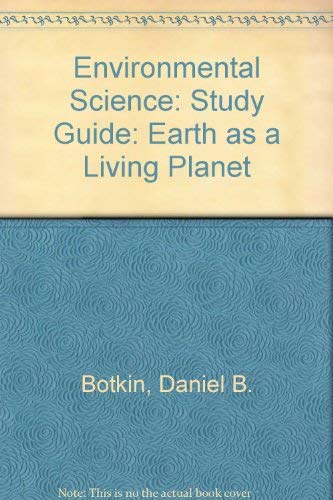Items related to Environmental Science, Study Guide: Earth as a Living...

"synopsis" may belong to another edition of this title.
Trained in physics and biology, Professor Botkin is a leader in the application of advanced technology to the study of the environment. The originator of widely used forest gap-models, he has conducted research on endangered species, characteristics of natural wilderness areas, the biosphere, and global environmental problems. During his career, Professor Botkin has advised the World Bank about tropical forests, biological diversity, and sustainability; the Rockefeller Foundation about global environmental issues; the government of Taiwan about approaches to solving environmental problems; and the state of California on the environmental problems; and the state of California on the environmental effects of water diversion on Mono Lake. He served as the primary advisor to the national Geographic Society for its centennial edition map on " The Endangered Earth." He directed a study for the states of Oregon and California concerning salmon and their forested habitats.
He has published many articles and books about environmental issues. His latest books are Beyond the Stoney Mountains: Nature in the American West from Lewis and Clark to Today (Oxford University Press), Strange Encounters: Adventures of a renegade Naturalist (Penguin/Tarcher), The Blue Planet (Wiley), Our Natural History: The Lessons of Lewis and Clark (Oxford University Press), Discordant Harmonies: A New Ecology for the 21st Century (Oxford University Press), and Forest Dynamics: An Ecological Model (Oxford University Press).
Professor Botkin was on the faculty of the Yale School of Forestry and Environmental Studies (1968-1974) and was a member of the staff of the Ecosystems Center at the Marine biological Laboratory, Woods Hole, MA (1975-1977). He received a B.A. from the University of Rochester, an M.A. from the University of Wisconsin, and a Ph.D. from Rutgers University.
Edward A. Keller was chair of the Environmental Studies and Hydrologic Sciences Programs from 1993 to 1997 and is Professor of Earth Science at the University of California, Santa Barbara, where he teaches earth surface processes, environmental geology, environmental science, river processes, and engineering geology. Prior to joining the faculty at Santa Barbara, he taught geomorphology, environmental studies, and earth science at the University of North Carolina, Charlotte. He was the 1982-1983 Hartley Visiting Professor at the University of Southampton, a Visiting Fellow in 2000 at Emmanuel College of Cambridge University, England, and recipient of the Easterbrook Distinguished Scientist award from the Geological Society of America in 2004.
Professor Keller has focused his research efforts into three areas: studies of Quaternary Stratigraphy and tectonics as they relate to earthquakes, active folding, and mountain building processes; hydrologic process and wildfire in the chaparral environment of Sothern California; and physical habitat requirements for the endangered Southern California Steelhead trout. he is the recipient of various Water Resources research Center grants to study fluvial processes and U.S. Geological Survey and Southern California Earthquake Center grants to study earthquake hazards.
Professor Keller has published numerous papers and is the author of the textbooks Environmental Geology, Introduction to Environmental Geology and (with Nicholas Pinter) Active Tectonics (Prentice-Hall). He holds bachelor's degrees in both geology and mathematics from California State University, Fresno; an M.S. in geology from the University of California; and a Ph.D. in geology from Purdue University.
"About this title" may belong to another edition of this title.
- PublisherWiley
- Publication date1994
- ISBN 10 0471597767
- ISBN 13 9780471597766
- BindingPaperback
- Edition number1
- Number of pages328
Shipping:
US$ 9.88
From United Kingdom to U.S.A.
Top Search Results from the AbeBooks Marketplace
Study Guide (Environmental Science: Earth as a Living Planet)
Book Description Condition: Good. Most items will be dispatched the same or the next working day. A few small marks or stains to the page edges/pages . Minor shelf wear. Previous owners name inside the front page/cover. Seller Inventory # wbb0022371414

